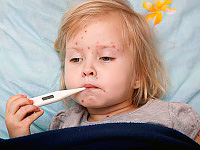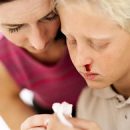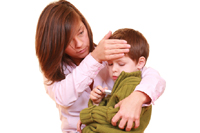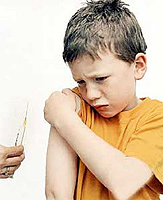Rubella virus - symptoms, causes, diagnosis and treatment of disease. Prevention of rubella.
Content
Rubella, or Rubella, — Viral disease causeing a characteristic rash on the body. Most often, children are ill. Especially dangerous rubella in pregnant women, adults with immunodeficiency. The effects of infection may be irreparable.
What is rubella? Causes of the disease
 The causative agent of rubella — Virus from the Togaviridae family. Path of infection — Air-drip. Infection is transmitted with coughing, sneezing, conversation. Incubation period — 1-2 weeks. Source of infection — sick man.
The causative agent of rubella — Virus from the Togaviridae family. Path of infection — Air-drip. Infection is transmitted with coughing, sneezing, conversation. Incubation period — 1-2 weeks. Source of infection — sick man.
After entering the mucous membrane of the nasophack, the virus penetrates the lymph nodes where it is intensively multiplied. After 5-6 days, the virions are determined in peripheral blood. The patient is infliced during the incubation period, before the rash and some time after.
Treatment of rubella
Symptoms of rubella in children
The disease begins with increasing temperature, increasing lymph nodes in the neck area. Temperature rarely exceed 38 °WITH. Then join flu-like symptoms — headache, weakness, malaise, bad appetite, pain in muscles and joints, throat. The disease is accompanied by conjunctivitis.
The first rashes on the face appear in a couple of days. Rubber rash has pink or light red. Elements are not towering above skin levels, have the kind of small spots. Characteristic symptom — The stage of appearance of new points. On the second day, rash appears on the body. By the end of the third day, she captures limbs. After four or five days, rashes begin to pale, disappearing without a trace, without depreciation or scars.
On the mucous side of the soft sky, small papulese red dots are found.
Reds in adults
The disease in adults is heavier than in children. Symptoms of intoxication are pronounced, fever, high temperature. Above the frequency of complications — pneumonia, encephalitis, myocarditis, etc. In patients with immunodeficiency, rubella can lead to severe viral infection, affecting internal organs, with high death (for example, with AIDS).
Rubella during pregnancy
The virus has a pronounced mutagenic effect, easily penetrates the placenta. The disease is especially dangerous in the first trimester of pregnancy. In 20% of cases, infection leads to miscarriages.
It is able to cause heart defects, developmental anomalies and fetal deformities in early pregnancy. There is a congenital form of illness. It is characterized by severe pathology of the nervous system, blindness, deafness, hepatitis and heart damage are possible. There is a shortage of body weight, anemia, thrombocytopenia.
Prevention of rubella
 Characteristic clinical manifestations make it possible to diagnose the disease based on the visible picture. In difficult and controversial cases, immununimal analysis or PCR is possible (polymerase chain reaction). These methods determine specific antibodies during rubella (class G immunoglobulins) and the presence of virus DNA in the blood, respectively.
Characteristic clinical manifestations make it possible to diagnose the disease based on the visible picture. In difficult and controversial cases, immununimal analysis or PCR is possible (polymerase chain reaction). These methods determine specific antibodies during rubella (class G immunoglobulins) and the presence of virus DNA in the blood, respectively.
A similar clinical picture has a cortex. The difference between the core rash from the rubella rashes is that its elements are prone to merger, after themselves leaves for hyperpigmentation, consist of small pitual formations. During rubella, foci do not merge. Cort takes place heavier, with high temperatures. Her characteristic symptom — Small white spots on the inner surface of the cheek, opposite the indigenous teeth. They are known as Belsky-Filatov's stains and arise only during a core infection.
Rubber treatment in children and adults
Specific methods of therapy are absent. Symptomatic methods are used to relieve the state of the patient and stimulation of immunity. Standard rubella treatment:
- anti-inflammatory and antipyretic drugs;
- disintellation therapy (abundant drink, infusion therapy);
- Immunostimulants and vitamins;
- Prevention of complications.
Antibiotics are prescribed only in the presence of secondary bacterial infection.
Prevention of rubella
Prior to the use of breast vaccination caused epidemics among children. Currently there are sporadic flashes of infection in the spring. Combined ving against measles, steam and rubella (PDA) applied. At the grafted children, the disease can flow in a light form.
For the prevention of the disease and its negative impact during pregnancy, a mandatory vaccination for girls in youthful age is recommended. It is usually well tolerated. Vaccination during pregnancy is prohibited.









